Is your back aging faster than you? Find out your back age
Currently the number of people leaving the workforce due to long-term sickness is at its highest since the 1990s, with musculoskeletal (MSK) health conditions coming in as a leading cause, behind mental health*.
Between 60% – 80% of Brits suffer from back pain within their lifetime, and with a sedentary lifestyle becoming more prevalent, it’s no surprise that MSK-related conditions are becoming increasingly common for chiropractors and other healthcare professionals to treat*.
This Back Care Awareness Week (7 October – 12 October 2024), the British Chiropractic Association (BCA) has created The Back Health Calculator – aiming to help Brits to gain a better understanding of their back health and how they can improve it.
Comprising of five simple exercises, which can be done at home, The Back Health Calculator guides the user through the exercises and shares a back health age, as well as guidance on whether their back falls within the ‘green, amber or red’ health brackets.
Speaking on The Back Health Calculator, Philippa Oakley and Kathryn Deverson, chiropractors and members of the BCA, said: “The state of the public’s back health is at an all-time low, despite the fact that our backs provide vital support throughout our day-to-day routines. The BCA’s new Back Health Calculator aims to show the current status of the general public’s back health and provides advice and tips on how to improve it.”
If you have any pre-existing conditions, injuries or are currently experiencing back pain, please follow guidance from your chiropractor or other healthcare professional before completing any exercises.
The Back Health Calculator Test
Exercise 1 – 30-Second Sit to Stand Test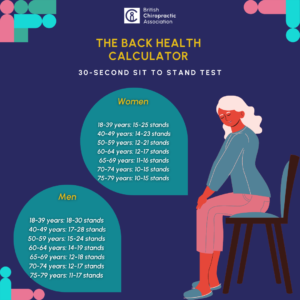
This exercise is designed to test leg strength and endurance in older adults, lower scores could indicate a risk of falls. This can also be used as a physical performance test in younger adults and athletes.
Starting from a comfortable seated position on a chair, cross your arms over your chest and gently raise yourself to a standing position. Depending on your age and gender you should be able to complete between 15 – 30 repetitions. See the video above for an example on how to perform this test.
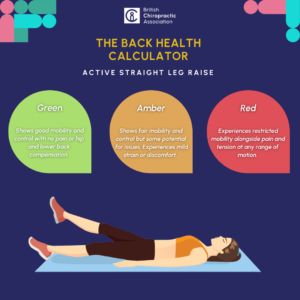 Exercise 2 – Active Straight Leg Raise
Exercise 2 – Active Straight Leg Raise
This test assesses how well an individual can cope with transferring load through the pelvis and lower back.
Start by laying flat on your back and slowly raise each leg about 20-centimetres. If you experience any strain through the lower back or pelvis, this could indicate an issue. See the video above for an example on how to perform this exercise.
Exercise 3 – Curl Up 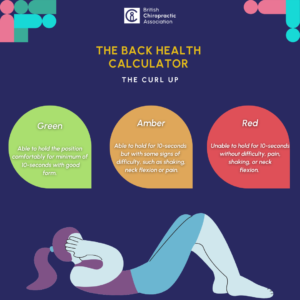
The curl up exercise helps the user to gain a better understanding of the strength of the deep core stabiliser muscles, and how they can cope with limiting excessive movement in the lower back.
Start by laying flat on the floor, with your hands in the arch of your back, one leg bent and raised with your neck slightly above the floor and hold it for 10-seconds. Any raising of the chin, pain in the neck and shoulders, are all things to watch out for. See the video above for an example on how to perform this exercise.
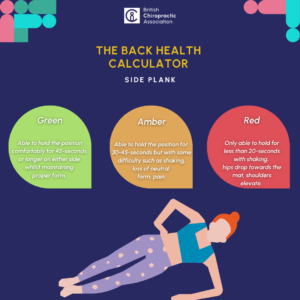 Exercise 4 – Side Plank
Exercise 4 – Side Plank
The side plank looks at core stability with a specific focus on side muscles, and how well they are able to cope with limiting excessive movement.
Start by laying on your side, with your hips and knees stacked on top of one another and use your bent arm to slowly raise yourself off the ground. If this feels too easy extend your legs. See the video above for an example on how to perform this exercise.
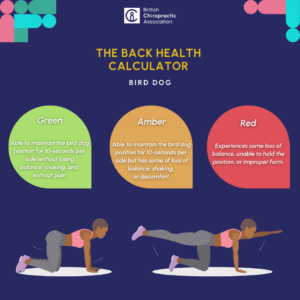 Exercise 5 – Bird Dog
Exercise 5 – Bird Dog
The bird dog exercise helps to show how well the spine can cope with transferring movement.
Start on your hands and knees on the floor, while keeping your back nice and flat – slowly extend the opposite arm and leg to a full stretch, returning to your starting position and completing the same movement on the other side. If you start to experience any movement, shaking or pain, this could indicate an issue with your spine and back. See the video above for an example on how to perform this exercise.
References:
*Office for National Statistics – Sickness absence in the UK Labour Market
*Waddell G, Burton AK. Occupational health guidelines for the management of low back pain at work: evidence review. Occup Med (Lond). 2001 Mar;51(2):124-35. doi: 10.1093/occmed/51.2.124. PMID: 11307688.
For further information, please contact bca@grayling.com
About the British Chiropractic Association:
The BCA is the largest and longest-standing association for chiropractors in the UK and has been named ‘Best Professional Body of the Year’ at the Memcom Excellence Awards 2022 for its Repositioning Project which has played a pivotal role in changing the healthcare landscape for the better. As well as promoting international standards of education and exemplary conduct, the BCA supports chiropractors to progress and develop to fulfil their professional ambitions with honour and integrity, at every step. The BCA is raising awareness about the rigour, relevance and evidence driving the profession and the association’s ambition for chiropractic to be more closely embedded within mainstream healthcare.
The BCA is the home for chiropractors who provide patient-centred, evidence-based care and offer full transparency to their patients. Through the Patient Charter BCA chiropractors provide reassurance to their patients and that they will empower them to make an informed decision about their treatment.
